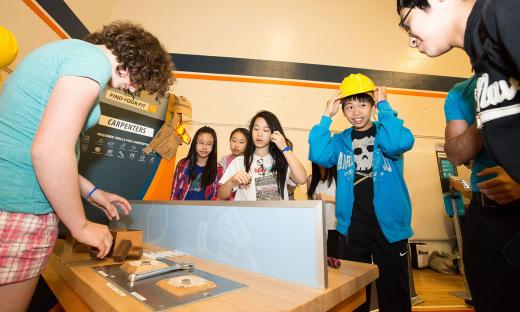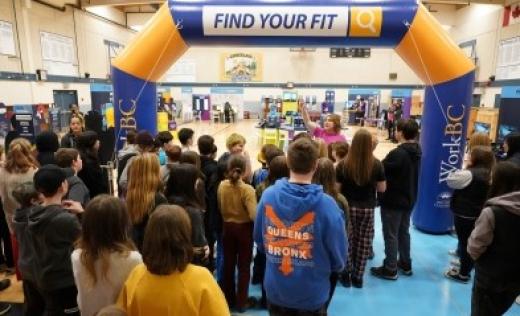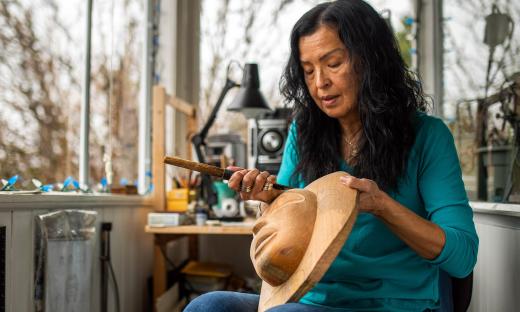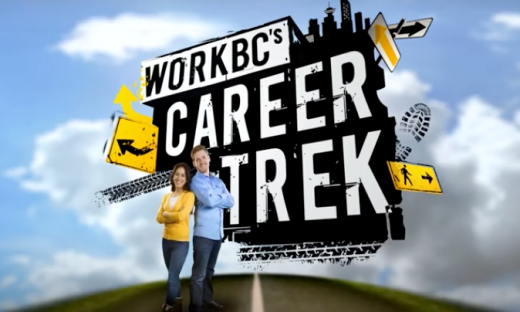This learning activity is designed to give grade 8 and 9 students an opportunity to use their community-based learning experience and research skills to explore occupations and career clusters. Experiencing workplaces, interacting with people in various occupations, and reflecting on their options for a career pathway are key competencies for students to develop and refine as they prepare for grades 10-12 and life after graduation.
-
100 KB
-
57 KB
-
174 KB
-
53 KB
-
120 KB
In Career Education 8 and 9, students will explore the world of work and identify work and learning pathways that can start them on their lifelong career journey. During this learning activity students will conduct personal research on occupations, jobs, career clusters and career pathways reflecting on their own experience and how the lesson may influence their future work and learning choices.
Worksheet A: Occupations, Jobs, Career Clusters and Career Pathways (available for download)
Worksheet B: Reflection (available for download)
Explore Training and Education
Other Requirements: Computer, tablet or smartphone.

Explore the WorkBC online resources that support this lesson.
If students run out of time on the computer, they can print it, email it to themselves or save it (if they’ve created an account and logged in).
If the student is with a mentor whose occupation is not included on WorkBC, you may need to help them find a related occupation by selecting the “Occupation categories” tab on Career Profiles and choosing a relevant category from the dropdown menu.
- What sections of the WorkBC resource will be most useful to you as you plan your future?
- What are the connections between the mentor occupations and the possible career clusters identified at the workplace?
- Of the occupations you learned about, which, if any, would be of interest to you as a career option? Why?
- When you interviewed your mentor, did you get a sense of how their interests and passions support their local community? What about the global community?
- How do you think the local economy of a community impacts the availability and types of jobs in that community? What about their impact on occupational choices?
- Do you think your community learning experience and conversations with your mentor will help you make future career decisions? Why?
- When thinking about your own career pathway, could you use the network you developed during your community experience to help you select future courses?
In Career Education grades 8/9, students develop their awareness of the world of work and the value of work in their lives, communities and society. Going out into the world and being in the world is an important “Big Idea” in the Career Education curriculum.
This learning activity is designed to give students an opportunity to use their community-based learning experience and research skills to explore occupations and career clusters. Experiencing workplaces, interacting with people in various occupations, and reflecting on one’s own options for a career pathway are key competencies for students to develop and refine as they prepare for grades 10-12, and life after graduation.
- Research occupations using WorkBC.ca.
- Explore occupations and careers via an interview with a community mentor.
- Collaborate to research career clusters.
- Create a product that represents findings.
- Share information with classmates.
- Reflect on experiences and how they influence personal career choices.
This activity will require co-ordination by the teacher to ensure each student in the class is engaged in an experiential community learning activity or has an alternative learning activity. Experiential community learning activities could include:
- “Take Our Kids to Work” events.
- Volunteering at school or in the community.
- Part-time jobs.
- Job shadowing.
- Interacting with a mentor, coach, elder or family member.
Teachers will need to collect information about each student’s situation prior to starting this lesson to ensure each student has a mentor and knows the occupation of their mentor.
Note: The interview with the mentor will likely be a homework assignment. If a face-to-face interview is too difficult for a student to schedule, suggest using Skype or FaceTime or a phone interview.
Activities and Tasks
Internet Research
This activity will use the WorkBC.ca resource and apply a variety of research skills to expand students’ knowledge of diverse career clusters and pathways. This foundational knowledge will help students reflect on a variety of career options.
This may be the first-time students are introduced to terms such as “occupation,” “occupational profile,” “job,” “career,” “career profile” and “career cluster.” As these terms are foundational to career planning activities, teachers will need to ensure students understand them.
Note: The words “jobs” and “careers” are used interchangeably on WorkBC.ca.
- Vocabulary: occupation, occupational profile, job, career and career cluster.
- Occupation: is a term that describes a person’s livelihood, vocation or regular source of income. Canada’s National Occupational Classification (NOC) defines an occupation as “a collection of jobs, sufficiently similar in work performed to be grouped under a common label for classification purposes.”
- Occupations most often have a common set of skills, knowledge, competencies and abilities.
- The NOC identifies and groups occupations mainly by the work normally performed including tasks, duties and responsibilities.
- The NOC groupings also factor in such aspects as materials used, industrial processes and equipment, level of responsibility, work complexity and the products made, and services provided.
- Examples of occupations include nurses, carpenters, cashiers, gas fitters and medical laboratory technicians.
- Note: Many people use the terms “job” and “occupation” interchangeably. Occupation is a title used to describe a broad group while a job is what people do when they work.
- Occupational profiles: provide a description, current snapshot and future projections about detailed occupational groups and help people make decisions related to future career plans. An occupational profile answers questions such as:
- What would work be like in this occupation?
- What education and credentials do I need to work in certain occupations?
- Where would I work if I trained for this job?
- Will there be jobs in this occupation in the future?
- How much money will I make working in this occupation?
- Job: A person's job is their role in society. A job is an activity, often regular and often performed in exchange for payment. A job encompasses all the tasks carried out by a particular worker to complete their duties.
- Many people have multiple jobs, such as those of parent, homemaker and employee. A person can begin a job by becoming an employee, volunteering, starting a business or becoming a parent.
- The duration of a job may range from an hour (in the case of odd jobs) to a lifetime.
- An activity that requires a person's mental or physical effort is work (as in "a day's work").
- If a person is trained and holds credentials for a certain type of job, they may have a profession or trade.
- Career: A career is the progress and actions taken by a person throughout a lifetime, especially those related to that person's occupation(s) and their education/training.
- A career is often composed of the jobs held, titles earned and work accomplished over a long period of time, rather than just referring to one position.
- While employees in some cultures and economies stay with one job during their career, there is a growing trend of employees changing jobs more frequently. For example, an individual's career could involve being a lawyer, although the individual could work for several different organizations and in several different areas of law over a lifetime.
- This trajectory is often referred to as a career pathway.
- Career cluster: A career cluster is group of occupations that share common features or a group of jobs and industries related by skills or products. If a person likes one occupation in a cluster, they will probably find other occupations in that cluster they also like. If someone lacks the academic qualifications for one occupation, they may find another more accessible occupation in the same field.
- Within each cluster, specific career pathways have their own knowledge and skill requirements, with related education and training programs.
- Examples of three different career clusters include:
- Health—Workers in this cluster enable people to have healthy lives. Some work directly with people, while others do not. This cluster contains jobs like home health aide, medical sonographer, pharmacy aide and medical transcriptionist.
- Business—Workers in this cluster help companies run smoothly. This cluster contains jobs like office clerk, receptionist, credit checker and janitor.
- Public Safety—Workers in this cluster protect people and enforce laws. This cluster contains jobs like security guard, court clerk, alarm installer and lifeguard.
- Additional information about career development terms can be found:
- Occupation: is a term that describes a person’s livelihood, vocation or regular source of income. Canada’s National Occupational Classification (NOC) defines an occupation as “a collection of jobs, sufficiently similar in work performed to be grouped under a common label for classification purposes.”
- Have students share their mentor’s occupation. Put career cluster headings on poster boards and populate the sheets as the students name off their occupations. Alternately, have students record which career cluster an occupation falls under.
- Demonstrate how to use WorkBC.ca with a link to the website. Highlight the information that students will be looking for.
- Demonstrate features using one student’s occupation or the example of a familiar occupation such as nurse, carpenter or cashier.
- Review the details of the occupational profile, including the education/training requirements, related occupations, industry information and regional information.
- Review Worksheet A (student overview, recording sheets, interview information and sample interview questions).
- Using WorkBC resources, ask students to research the mentor’s occupation and record their findings on the summary table on Worksheet A.
- Students can do this collaboratively if there are several students in each career cluster.
Assessment Ideas
Self-Assessment
Ask students to provide evidence of the statements:
- I can use WorkBC.ca to explore additional occupations and/or use the website to show my friends and family the occupations I’m interested in.
- I can explain the characteristics of my mentor’s occupation to my classmates.
- I feel prepared to discuss my mentor’s occupation with him/her.
Part One: Interview (Primary Research)
Students will expand their knowledge of careers through a one-on-one interview with their community mentor. Students will collaboratively prepare interview questions to help them gather additional information about their mentor’s occupation and career path.
Note: Teachers may need to prepare students on how to conduct an interview.
- Review the interview information sheet (Worksheet A) to help students set up the interview place and time.
- Remind students to give you their interview place and time so a schedule can be created to track interview completions. An electronic calendar can be used.
- Provide students with the sample questions (Worksheet A) so they can create their own interview approach.
- Ask students to move into groups, based on the career clusters identified in Activity One, and help each other generate a minimum of ten interview questions. Have students include questions related to their mentor’s occupation, job, career and career cluster (as defined above). Questions can also help them explore their mentor’s workplace and how the mentor chose his/her career. Have them think about the WorkBC research they did and if they have additional questions about the occupation.
- Review each student’s interview questions prior to the interview activity and, if needed, make suggestions for revision. Note: Some students may need to practice their interview questions by doing mock interviews.
- Ask students to complete the interview as per the schedule and record answers on their interview sheet.
- Following the interview, suggest that students send a handwritten thank you card or short email/text (as appropriate) to their mentor.
Expand Student Understanding of Career Clusters
Through further research, students will understand connections between the mentor’s occupation and the possible career cluster identified at the workplace. If possible, they should highlight different education and/or training requirements for each job.
- Class discussion:
- Ask students to share some of the different types of occupations they identified during their interview.
- Ask students to add these occupations to the career cluster sheets populated in Activity One, Item 2.
- Help students understand the importance of career clusters as a career-planning concept. Have them think about the factors that influence the occupations and career clusters that can be found in a workplace. For example: the effects of local or global influences or the size of the organization.
- Ask students to use WorkBC.ca to investigate two additional occupations they identified during their community experience. They can do this collaboratively.
- Ask students to capture their information summary and interview results. Options include:
- Create a digital book using the Book Creator App on the iPad or similar app.
- Create a mind map using chart paper.
- Create a collaborative presentation using Google Slide or Microsoft PowerPoint.
- Create a poster using the Pic Collage app on the iPad or a paper format.
- Create a poster that represents a summary of what they learned in the community about occupations and career clusters.
- When students are finished have them share what they created (their “product”) with the class.
Assessment Ideas
Self-Assessment
Ask students to provide evidence of the statements:
- I created a product that represents the career cluster I explored while using WorkBC.ca and through my interview with my mentor.
- I put a link in my product to my occupation found on Career Trek (if applicable).
- I had a peer review my product and received feedback for improvement.
- I shared the product with the class so they learned about a new career cluster.
Teacher Assessment
Teacher creates a rubric to assess “product.”
Part Two: Reflection
Students will learn about additional career clusters to help them expand their knowledge of the work they learned about in the community. They will do this by sharing the product they created based on their research, viewing of Career Trek videos and interviews with mentors.
Using Worksheet B, review the activity and ask them to form small groups. Identify one student in each group to act as a leader, and have them use the following discussion questions as conversation starters.
- Were you surprised by the number of occupations you discovered in your community work experience? Why?
- What are the three occupations you researched? What was one interesting thing you learned about each occupation?
- Do you think they are part of a career cluster? Why? Can you describe the career cluster? What were some of the things that influenced your mentor’s career choice?
- Did any of the occupations interest you?
Ask students to individually answer the following reflection questions and hand in their responses as an exit slip. Teachers may need to review the questions:
- What section of the WorkBC.ca resource will be most helpful for your future career planning? Why and how will you use it?
- What are the connections between the mentor occupation(s) and the possible career cluster identified at the workplace?
- Of the occupations you learned about, which one, if any, would be of interest to you? Why?
- When you interviewed your mentor, did you get a sense of how their interests and passions support the needs of the local and global community?
- How do you think the local economy impacts occupational choices and the availability of jobs?
- Do you think your community learning experience and conversations with your mentor will help you make future career decisions? Why?
- When thinking about a career pathway, could you use the network you developed during your community experience to help you select future courses?
Assessment Ideas
Teacher Assessment
- Ask students to hand in the reflection questions as an exit slip.
- Collect the reflection questions as an exit slip.
- Use the responses to the reflection questions to inform the success of the learning activity and as a way to make improvements for future learning plans.
This lesson plan supports elements of British Columbia's Career Education Curriculum as outlined below. For further details on the curriculum itself, visit the Ministry of Education's Career Education Curriculum webpage.
- Adapting to economic and labour market changes requires flexibility.
- Our career paths reflect the personal, community and educational choices we make.
- Connections to Community:
- Local and global needs and opportunities.
- Factors affecting types of jobs in the community.
- Life and Career Plan:
- Role of community, school, personal network and mentorship in career planning.
- Interact: Question yourself and others about how individual purposes and passions can support the needs of the local and global community when considering career choices.
- Share: Appreciate the value of a network of resources and mentors to assist with career exploration.
- Initiate: Apply a variety of research skills to expand their knowledge of diverse career possibilities and understand career clusters.
- Communication:
- Connect and engage with others (to share and develop ideas).
- Critical thinking.








